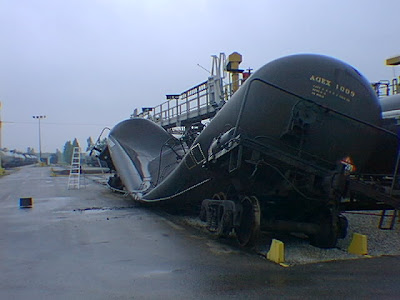Wednesday, April 9, 2008
Display problem ? Click HERE
Benoy in his early thread " Vacuum For Pressure Vessel Design" has triggered to think a little more on an old subject "Vacuum Hazard".
What is Vacuum Hazard ?
Vacuum or negative pressure can be dangerous and damaging to vessel as many vessel structures may not be built to withstand reversed stresses caused by negative pressure or vacuum. Following images show vessel collapsed caused by Vacuum.
What are the main factors resulting Vacuum ?
TWO main factors are potentially the best candidates result Vacuum in a vessel. There are External mechanical draw and Internal contraction.
Several scenario you may have to consider potential of Vacuum Hazard
i) Vessel containing fluid with vapor pressure at minimum ambient temperature lower than atmospheric. Typical example is the steam-condensate system. A steam drum shut down and cool down normal ambient cooling. As the steam cooled, it will start to condense and condensation lead to sudden volume contraction and this potential causing partial vacuum condition in the steam drum. Main factor is internal contraction due to heat loss.
ii) Atmospheric tank storing hot liquid. Similarly external cooling would cause liquid contraction and lead to partial vacuum in the tank. Main factor is internal contraction due to heat loss.
iii) Gravity draining of vessel filled with low vapor pressure (VP) liquid (i.e. water). Draining of low VP liquid out from vessel (completely blocked) would results negative pressure or partial vacuum in the vessel due to liquid column. Main factor is external mechanical draw by gravity force.
iv) Reciprocating pump drawing low VP liquid from vessel. Reciprocating pump continue drawing liquid from vessel would also lead to vacuum in the vessel. Again, the main factor is external mechanical draw by mechanical force.
v) Hot Relief into Flare Header. After a hot gas relief into the flare header, the hot gas in the header will be cooled by ambient. This would be accelerated with raining, snowing, winter, etc. Again, hot gas cooling may result condensation and potential create partial vacuum in the flare header. Main factor is internal contraction due to heat loss.
vi) Blocked Vent line. Bird nest or plastic in the vent line would partially or completely blocked the vent line. This potentially causing partial vacuum in the tank when the tank is cooled or pump-out. Main factor could be internal contraction due to heat loss or external mechanical draw by mechanical force.
Thus, vacuum may be a hazard and damaging factor to your system. It shall be addressed and extra caution to be taken during design, construction, operation and maintenance to avoid catastrophic failure.
Click to read 4-steps Approach to Combat Vacuum Hazard ...
Related Post
WebWorm
What are the main factors resulting Vacuum ?
TWO main factors are potentially the best candidates result Vacuum in a vessel. There are External mechanical draw and Internal contraction.
- External mechanical draw
This factor basically cause by a external mechanical force to draw mass in the vessel out and creating vacuum in the vessel. Typical example are vacuum compressor, steam ejector, etc.
- Internal Contraction
Temperature different results internal heat is forced to transmit out from the vessel and internal fluid experience sudden contraction due to condensation. Typical example is steam-condensate drum.
Several scenario you may have to consider potential of Vacuum Hazard
i) Vessel containing fluid with vapor pressure at minimum ambient temperature lower than atmospheric. Typical example is the steam-condensate system. A steam drum shut down and cool down normal ambient cooling. As the steam cooled, it will start to condense and condensation lead to sudden volume contraction and this potential causing partial vacuum condition in the steam drum. Main factor is internal contraction due to heat loss.
ii) Atmospheric tank storing hot liquid. Similarly external cooling would cause liquid contraction and lead to partial vacuum in the tank. Main factor is internal contraction due to heat loss.
iii) Gravity draining of vessel filled with low vapor pressure (VP) liquid (i.e. water). Draining of low VP liquid out from vessel (completely blocked) would results negative pressure or partial vacuum in the vessel due to liquid column. Main factor is external mechanical draw by gravity force.
iv) Reciprocating pump drawing low VP liquid from vessel. Reciprocating pump continue drawing liquid from vessel would also lead to vacuum in the vessel. Again, the main factor is external mechanical draw by mechanical force.
v) Hot Relief into Flare Header. After a hot gas relief into the flare header, the hot gas in the header will be cooled by ambient. This would be accelerated with raining, snowing, winter, etc. Again, hot gas cooling may result condensation and potential create partial vacuum in the flare header. Main factor is internal contraction due to heat loss.
vi) Blocked Vent line. Bird nest or plastic in the vent line would partially or completely blocked the vent line. This potentially causing partial vacuum in the tank when the tank is cooled or pump-out. Main factor could be internal contraction due to heat loss or external mechanical draw by mechanical force.
Thus, vacuum may be a hazard and damaging factor to your system. It shall be addressed and extra caution to be taken during design, construction, operation and maintenance to avoid catastrophic failure.
Click to read 4-steps Approach to Combat Vacuum Hazard ...
Related Post
- 4-steps Approach to Combat Vacuum Hazard
- Parallel Valve Technology Increase Safety & Reduce Nuisance Trips
- Dust Explosion Basic & Protection
- Why not bury flare pipe header ?
- Extra Caution When Eliminating Overpressure by Fire Attacks
- Blast rocks Texas oil refinery
- Petrol Kiosk - Some Thought and Advices...
- Design fault in Hydrogen Attack of Residue Hydrodesulfurrization
WebWorm

0 Comments:
Post a Comment
Let us know your opinion !!! You can use some HTML tags, such as <b>, <i>, <a>
Subscribe to Post Comments [Atom]
Home:
<< Home